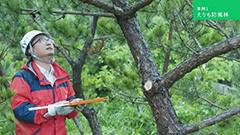Used in JICA Knowledge Co-Creation Program in the field of forestry
We tried using JICA-Net multimedia-based learning material, "Japan's Approach to Sustainable Forest Management" (YouTube, external link) , in JICA Knowledge Co-Creation Program, "Forestry remote sensing" (a remote training), held from July 11th to September 8th, 2022.
Aiming to reduce the greenhouse gases in developing countries (REDD+), produced by the reduction and deterioration of forests, this training intends for trainees to learn a basic remote sensing technology to grasp the dynamic state of forest resources that was important for sustainable forest management, and also to improve their basic ability of GIS technology which is necessary to make a database in their own countries.
7 participants from Kosovo, Brazil, Moldova, and Bangladesh took part in the training.
Introduce the history of Japan's forests and the effort for sustainable use.

Case1: Erimo Town, which has implemented a greening project for over 50 years and succeeded to recover the forest, which had turned into a desert
About two-thirds of Japan's total land is covered in forests, one of the highest proportions of forested in the world. But Japan's forests have not always been bountiful.
In the first half, the material looks back on the history of how Japan recovered forests, which had been reduced to about half of the total land due to deforestation. Then, it explains the current status of forests and various systems for forest management.
In the second half, it takes 4 examples aiming for sustainable forest management in Hokkaido, which has about a quarter of Japan's total forest area: Erimo Town, which has implemented a greening project for over 50 years and succeeded to recover the forest, which had turned into a desert, and also the ecosystem in the sea. Shimokawa Town, which is operating forest management based on cyclic use of resources, and aims to "Integrate forestry and wood industry", which means using all the wood produced without creating any waste. Asahikawa City, which has branded Asahikawa Furniture, utilizes local materials and changed ordinary craftsmanship to design-based craftsmanship. University of Tokyo Hokkaido Forest, where forest management experiments are conducted, whose goal is growing dynamic forests with high resistance.

Case 3: Asahikawa Furniture, which changed ordinary craftsmanship to design-based craftsmanship.
The material introduces these examples with many videos and interviews on the local site
The material that could be used in various cases
In this training, we shared the URL with the trainees and then watch it with a video of technology training.
We introduce the comments from the course leader of the training who helped us.
-
1
.
Today, Japan faces the problem of underutilization of forests. On the other hand, trainees' countries face the problem of overutilization of forests.
Only looking at the current situation, both problems are the opposite of each other. For that reason, there was a mismatch between the issues faced by the trainees and the contents of the training. However, because the history of Japan's forest use includes the fact that the overutilization was repeated during WWII and the economic growth after that, the material was useful to introduce that part. Especially, I think it is suitable for Central and South Americans of Japanese descent who participate "Training program for Nikkei communities" to understand Japan's history. - 2 . Meanwhile, the mismatched part of the contents in the material is useful to learn the effort made in Japan. By viewing the material from beginning to end, the general public are able to understand the history and the development of Japan's forest management and the effort for issues on the whole. The material is helpful in various cases and I would like to use it in the future.
SUGAWARA Kiyohide
Training Program Division
Hokkaido Center (Sapporo)
*The Material(s) mainly applied
Japan's Approach to Sustainable Forest Management
This material broadly explains Japanese development experience as of sustainable forest management, including background of development of forestry sectors, forest system, greening project, plantation management and sustainable wood use.
The material was created to publicize and disseminate Japanese development experiences of sustainable forest management.
Suggested uses for this material include university lectures, development and international relations courses, and training sessions in Japan and abroad.




scroll